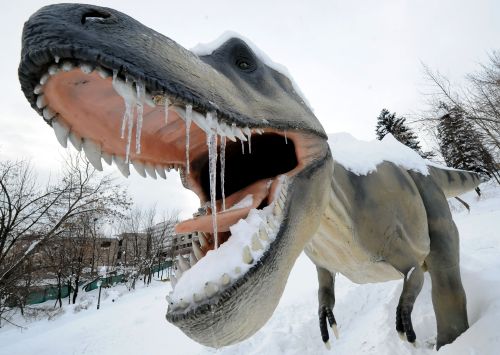Giant dinosaurs that roamed the Earth millions of years ago may have warmed the planet with the gas they produced from eating leafy plants, British scientists said on Monday.

Much like modern cows that emit a significant amount of methane in their digestive process, the 20,000 kilogram sauropods contributed the same way, and likely more, to the warming climate, said the study in the US journal Current Biology.
The climate during the Mesozoic Era, which spanned 250 million years ago to about 65 million years ago, was believed to be hotter than it is today.
With bulky bodies and long necks that allowed sauropods like the Brontosaurus to graze on grasses or high in the treetops, these creatures were plentiful 150 million years ago, ranging from a few individuals to a few dozen per square kilometer.
In all they may have emitted a total of 520 million tons per year of global methane emissions, a level that is comparable to the total given off today by animals and industrial activities, the study authors said.
Currently 80 million metric tons of methane are produced annually by global livestock, making up about 28 percent of global methane emissions from human-related activities according to the US Environmental Protection Agency.
"A simple mathematical model suggests that the microbes living in sauropod dinosaurs may have produced enough methane to have an important effect on the Mesozoic climate," said Dave Wilkinson of Liverpool John Moores University.
"Indeed, our calculations suggest that these dinosaurs could have produced more methane than all modern sources -- both natural and man-made -- put together."
About 150 years ago, before modern industry took hold, methane emissions were about 200 Tg per year, less than half that of the Mesozoic Era. (AFP)
<관련 한글 기사>
'속이 좀...'공룡들, 방귀로 대재앙 일으켜!
약 1억5천만년 전에 일어난 지구 온난화 현상은 거대한 초식공룡들이 배출한 엄청난 양의 방귀와 트림이 주요인일 가능성이 있다는 최신 연구가 나왔다고 사이언스 데일리와 BBC 뉴스가 7일 보도했다.
영국 과학자들은 소의 소화관에서 배출되는 가스의 양을 근거로 브론토사우루스를 포함한 용각류(龍脚類: 초식공룡의 총칭)들이 배출했을 가스의 양을 계산한 결과 연간 5억2천만t이라는 수치가 나왔으며 이는 온난화의 주요인이 됐을만한 양이라고 커런트 바이올로지 최신호에 발표했다.
연구진은 지금보다 기온이 최고 10℃나 높고 습도도 높았던 중생대(약 2억4천만 ~6천500만년 전)의 온난화 현상을 설명하는데 공룡의 역할을 빼놓을 수 없다고 지적 했다.
약 1억5천만년 전 지구를 지배했던 공룡들, 그 중에서도 어마어마한 몸집과 유난히 긴 목을 갖고 있던 용각류는 초식성으로 장내 미생물의 도움을 받아야 먹이를 소화시켰다.
중간 정도의 몸집을 가진 용각류의 몸무게는 약 20t으로 추정되며 이들은 1㎢당 어른 서너 마리에서 수십마리까지 살았을 것으로 추정된다.
연구진은 오늘날 지구상의 소와 염소, 기린 등 초식동물들이 배출하는 가스의 양이 연간 5천만~1억t이며 몸 크기에 비례해 공룡들이 배출했을 가스의 양은 연간 5 억2천만t으로 추산된다고 밝혔다. 이는 동물 생리학자들이 다양한 동물들을 대상으로 한 연구에서 얻은 공식을 적용한 것이다.
한편 오늘날 야생동물 같은 자연적인 원인과 낙농ㆍ육류 생산 등 인간 활동에서 배출되는 메탄가스의 총량은 약 5억t으로 추산된다.
이에 비해 산업화가 시작되기 전인 약 150년 전 전세계의 메탄가스 배출량은 연 간 2억t에 불과했다.
연구진은 이는 "지구의 메커니즘이가 얼마나 신기하고 놀라운 것인지 보여줄 뿐 아니라 지구 기후에 미생물과 메탄이 얼마나 중요한 역할을 하는지 상기시켜주는 것 "이라고 강조했다.
학자들은 그러나 공룡들이 이처럼 엄청난 양의 메탄가스를 방출했음에도 불구하고 이들의 방귀와 트림이 당시 온난화의 유일한 원인은 아니었을 것이라고 지적했다.
이들은 "중생대에는 그밖에도 다른 메탄 배출원들이 있었으므로 전체적인 메탄 농도는 오늘날보다 훨씬 높았을 것"이라고 말했다.





![[Herald Interview] 'Amid aging population, Korea to invite more young professionals from overseas'](http://res.heraldm.com/phpwas/restmb_idxmake.php?idx=644&simg=/content/image/2024/04/24/20240424050844_0.jpg&u=20240424200058)











![[KH Explains] Korean shipbuilding stocks rally: Real growth or bubble?](http://res.heraldm.com/phpwas/restmb_idxmake.php?idx=652&simg=/content/image/2024/04/25/20240425050656_0.jpg&u=)

